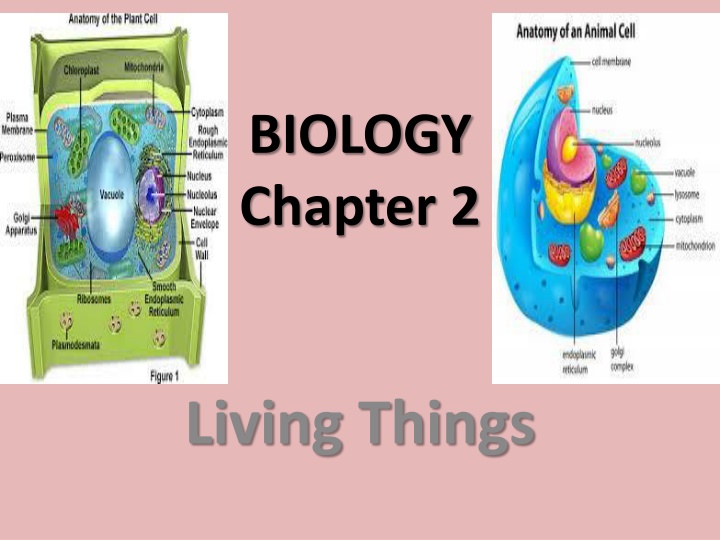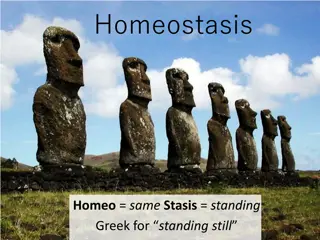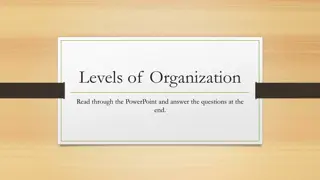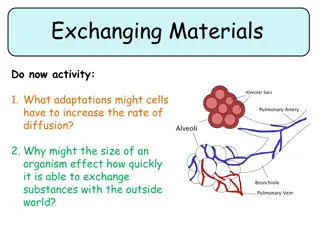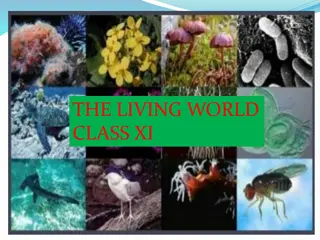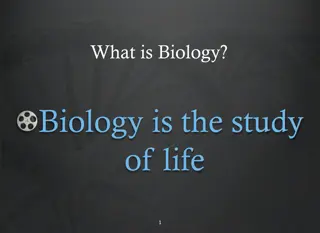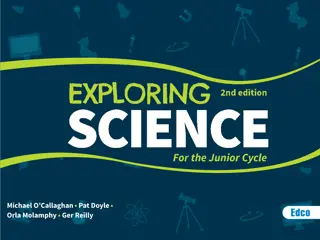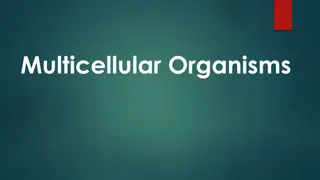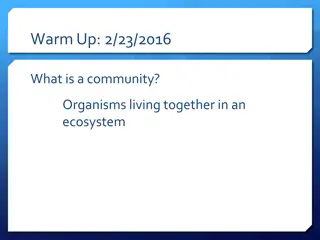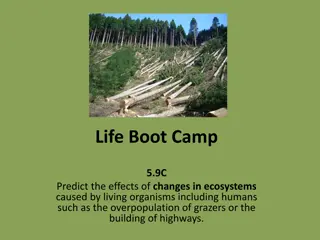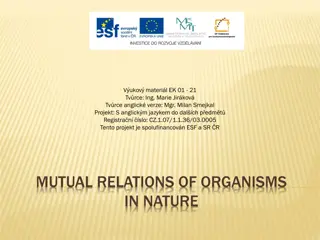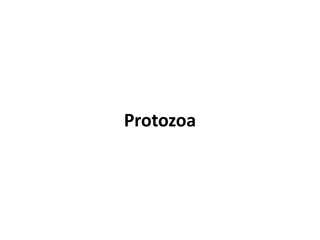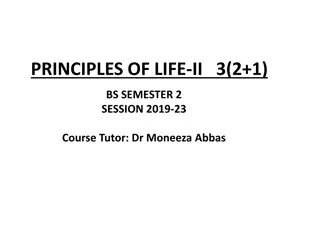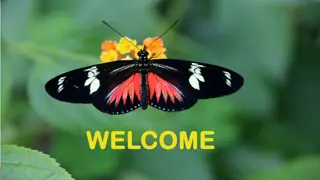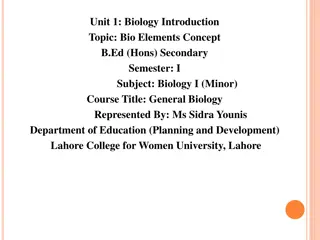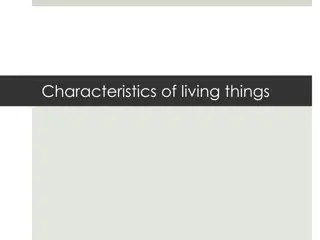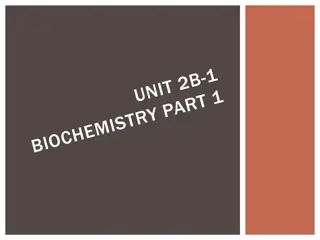Characteristics of Living Organisms
Living things, from unicellular organisms to complex multicellular beings, share common traits such as cellular organization, energy utilization, response to stimuli, growth and reproduction. Cells, the basic units of life, are composed of essential chemicals like water, carbohydrates, proteins, lipids, and nucleic acids. Growth, development, and reproduction are vital processes for survival, along with adaptation to changing environmental stimuli. The necessity of water, food, living space, and stable internal conditions underscores the fundamental requirements for life on Earth.
Uploaded on Feb 27, 2025 | 0 Views
Download Presentation

Please find below an Image/Link to download the presentation.
The content on the website is provided AS IS for your information and personal use only. It may not be sold, licensed, or shared on other websites without obtaining consent from the author.If you encounter any issues during the download, it is possible that the publisher has removed the file from their server.
You are allowed to download the files provided on this website for personal or commercial use, subject to the condition that they are used lawfully. All files are the property of their respective owners.
The content on the website is provided AS IS for your information and personal use only. It may not be sold, licensed, or shared on other websites without obtaining consent from the author.
E N D
Presentation Transcript
BIOLOGY Chapter 2 Living Things
Organism Living things. All living things share 6 characteristics: Have cellular organization, contain chemicals, use energy, respond to their surroundings, grow/develop, & reproduce.
Cell The basic unit of structure & function in an organism. Unicellular (Single Celled)- bacteria Multicellular (Many Cells)- specialized
Cells & Chemicals Cells are made of chemicals. Water (most abundant), carbohydrate (cell s energy source), proteins/lipids (building material for cells), Nucleic acid (genetic material for cell activities).
Cells use energy to grow & repair damaged parts.
Stimulus A change in an organism s surroundings that causes the organism to react. Changes in temp, light, sound Reaction of organism to stimulus- Response Car horn beeps- scares you.
Growth & Development Growth- process of becoming larger. Development- the process of change that occurs during an organism s life to produce a more complex organism.
Reproduction Ability to produce offspring that are similar to the parents. How living things are made.
What do living things need to survive? 1. Water 2. Food 3. Living Space 4. Stable Internal Conditions
FOOD Autotroph- organism that makes its own food. Plants Heterotroph- cannot make its own food, must consume other autotrophs or other heterotrophs.
Competition on Earth Earth is limited so organisms must COMPETE for food & space. Conditions on Earth change so organisms must be able to adapt to the changes to survive.
Homeostasis The maintenance of stable internal conditions despite changes in surroundings. Everything just right Being thirsty after a workout.
CELL The basic unit of structure & function in living things. They form the parts of an organism & carry out the functions of the organism.
Cell Structure & Function Structure- what it is made out of (the parts). Building- bricks, steel beams, drywall Function- processes that keep it alive- obtaining oxygen/food/digestion, growing, & reproduction.
Cell Size Very small and many of them 1 sq cm of your skin has 100,000 cells!
Microscope An instrument that makes small objects look larger. Can see cells under the microscope.
Cell Theory A widely accepted explanation of the relationship between cells & living things. It states: All living things are made of cells, Cells are the basic unit in living things, & All cells are produced by other cells.
Organelles Tiny cell structures that carry out specific functions inside the cell. Just like our stomach & heart do certain functions for us organelles do same for cell.
Cell Wall- a rigid layer that surrounds the plant cell. It protects & supports cell. Water/Oxygen & other materials can pass through it. Cell Membrane- next layer below the cell wall in plants & outer layer for animal cells. Controls what comes in/out of cell. Acts like a screen door.
Nucleus- cells control center (brain), directs all of the cell s activities. Nuclear Envelope- outer covering/shell of nucleus. It protects the nucleus. Allows materials to go in/out of nucleus.
Chromatin Thin strands floating in front of the nucleus that contain genetic material (instructions) for directing the cell s activities.
Nucleolus A small object floating in the nucleus. It contains ribosomes that produces proteins which are important contents for the cell.
Cytoplasm Region between the cell membrane & the nucleus. It is a clear, jell-like liquid surrounding the cell that is constantly moving. Contains many organelles of the cell.
Mitochondria The rod-shaped powerhouse of cell. Converts energy in food molecules to energy the cell can use to carry out functions.
Endoplasmic Reticulum Passageways in cytoplasm that carry proteins & other materials. Like hallways in a building.
Ribosomes Small, grain-like bodies that float in cytoplasm & function as factories that produce proteins.
Golgi Bodies Flattened sacs or tubes that receive materials from the Endoplasmic Reticulum & send them to other parts of cell. Also release materials outside the cell.
Chloroplasts Large green structures floating in the cytoplasm of plant cells. Captures energy from the sun & uses it to produce food for the cell. Makes leaves of plants green.
Vacuoles Large, water-filled sacs used for storage. Food, waste products, & other materials.
Lysosome Small, round structures that contain chemicals that break down materials in the cell. Cleanup crew- food, old cell parts (renew)
Cell Organization In multicellular organisms, cells are organized into tissues, organs, & organ systems. Tissue- group of similar cells that work together to perform a certain function.
